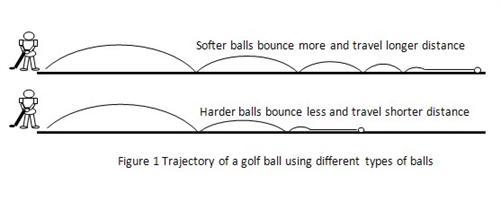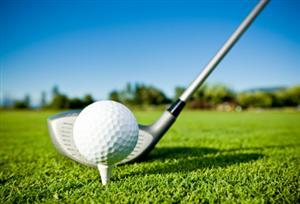| Complexity level: | 7 |
| Project cost ($): | 40 |
| Time required: | 1 hour to prepare, 4 hours for experiment |
| Material availability: | Easily found |
| Safety concerns: | Never stand anywhere in front of a golfer who's about to take a swing. Beware of swinging clubs - which can cause severe injury |
Hypothesis
Bouncier golf balls will be able to travel further than the less bouncy ones.
Overview
Why do balls bounce?
Balls are able to bounce as a result of the compression of air inside the ball. When a ball is raised above the ground, a ball gains potential energy. Releasing the ball from the raised position will result in the ball falling to the ground because of the gravitational pull of the Earth on the ball. The ball will accelerate and gain velocity.
As the ball falls to the ground, its potential energy is gradually reduced as it is converted into kinetic energy. As it approaches the ground, almost all of its potential energy would have been converted into kinetic energy. When the ball hits the ground, it will be compressed against the floor, and its initially round shape will become slightly altered (deformed). This will cause the air inside the ball to become compressed. The kinetic energy that the ball now has is momentarily stored in the air inside the ball as compressed (potential) energy. As the ball returns to its regular round shape, the compressed energy is again converted into kinetic energy, causing the ball to rebound upwards . As it rises, the kinetic energy is once more converted into potential energy. As the ball continues bouncing up and down, energy is gradually lost through friction between the surface of the ball and the air around it, friction of the air inside the ball due to the compression, and friction between the rubber molecules of the ball. This energy will be lost in the form of heat energy and the maximum bounce height reached by the ball will gradually decrease, with each bounce.
Scientific Terms
Materials
The materials required for this science fair project:
- 15 golf balls – 5 each from 3 different brands
- 3 amateur golfers
- 5 golf club (a driver). Have the golfers bring along their own club.
- A measuring tape
- A golf driving range
- An assistant to help with the measurement
- 1 black marker pen
Procedure
1. For this science fair project, the independent variable is the type of golf ball used – soft, medium or hard. The dependent variable is the distance traveled by the golf ball. This is determined by using a measuring tape to measure the distance traveled. The constants (control variables) are the skill of the golfer, the wind condition and the conditions at the driving range.
2. The golf balls are first numbered according to their brand and an assigned ball number by using a black marker pen.
3. The relative bounciness of the 3 brands of golf balls needs to be determined first. The balls are dropped onto a flat floor surface from a height of 1 meter and the number of bounces achieved by each ball is counted and recorded in table 1 given below.
4. Once the relative bounciness of the golf balls has been determined, the golfers are brought to the driving range for the next part of the experiment. Using the golf club (a driver), they are asked to take turns hitting the golf balls one at a time, and the distance traveled by each ball is measured. You will need to use the measuring tape for accurate measurements. Referring to the distance markers at the driving range will only provide a rough gauge of the distance travelled. Ensure that you conduct this experiment when there is no one else playing at the driving range - you probably will need to seek the permission/assistance of the driving range operator. The average distance traveled by each ball is calculated and the results are recorded in the table 2 given below.

Results
It is observed that the brand A golf balls have the highest number of bounces on average, and hence will be considered the most bouncy of the three. The brand C golf balls are the least bouncy.
| Golf ball brand | Number of bounces | |||||
| Ball 1 | Ball 2 | Ball 3 | Ball 4 | Ball 5 | Average | |
| Brand A | 8 | 7 | 8 | 6 | 7 | 7.2 |
| Brand B | 5 | 6 | 4 | 5 | 5 | 5 |
| Brand C | 3 | 5 | 3 | 4 | 3 | 3.6 |
It is also observed that the most bouncy type of ball (Brand A) traveled the furthest, while the least bouncy (Brand C) traveled the shortest distance.
| Brand type | Average distance traveled by the golf ball(meters) | |||||
| /td> | Ball 1 | Ball 2 | Ball 3 | Ball 4 | Ball 5 | Average |
| Brand A | 128.5 | 132.8 | 138.4 | 137.4 | 135.3 | 134.48 |
| Brand B | 117.3 | 119.6 | 121.9 | 122.7 | 115.6 | 119.42 |
| Brand C | 105.8 | 110.5 | 112.7 | 108.3 | 102.8 | 108.02 |
The results show that the bouncier balls are able to travel further compared to the less bouncy balls. Here's an illustration of what probably occured. Regardless of the distance of the flight of each ball, what probably happened was that the bouncier balls bounced a greater number of times and over a larger distance.

Conclusion
The hypothesis that the relatively bouncier golf balls will be able to travel further than the less bouncy ones, is proven to be true.
Manufacturers of golf balls spend a lot of money on research to improve the flight distance of the golf balls. Each golf ball manufacturer has its own techniques on how to improve the performance of their golf balls. Each brand of golf ball is constructed differently and will also perform differently under varying conditions. This gives golfers the opportunity to choose a ball that best fits their style of play.
Also consider
This science fair project can also be done using different sizes of golf clubs, like the a no. 7 iron.
Try changing the temperature of the ball by placing it in hot or cold water first before repeating the experiment.
What if the ground (ie: the fairway) is soggy after heavy rainfall? How does this affect the distance travelled by the ball?
References
Bouncing balls (energy) demo - http://www.physics.ucsb.edu/~circus/energydemo.htm
Bouncing balls home page - http://www.howeverythingworks.org/bouncing_balls.htm

